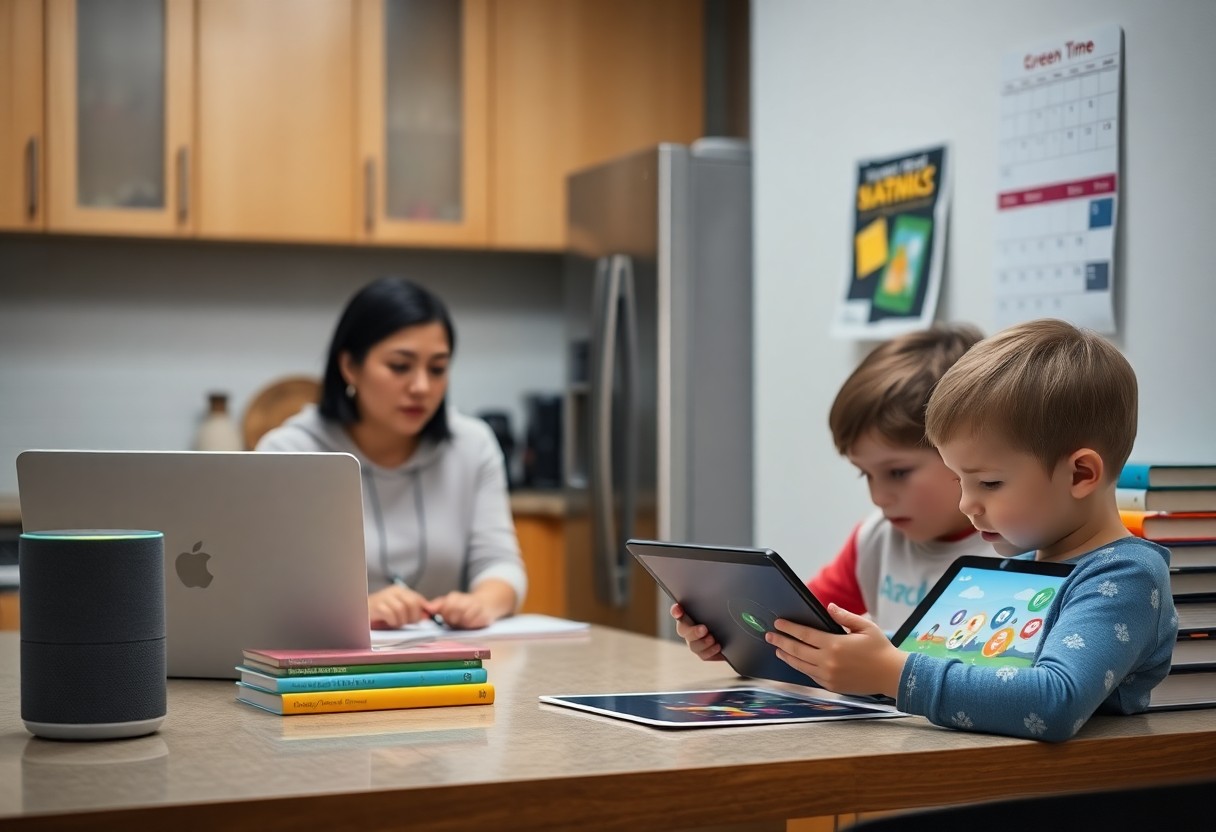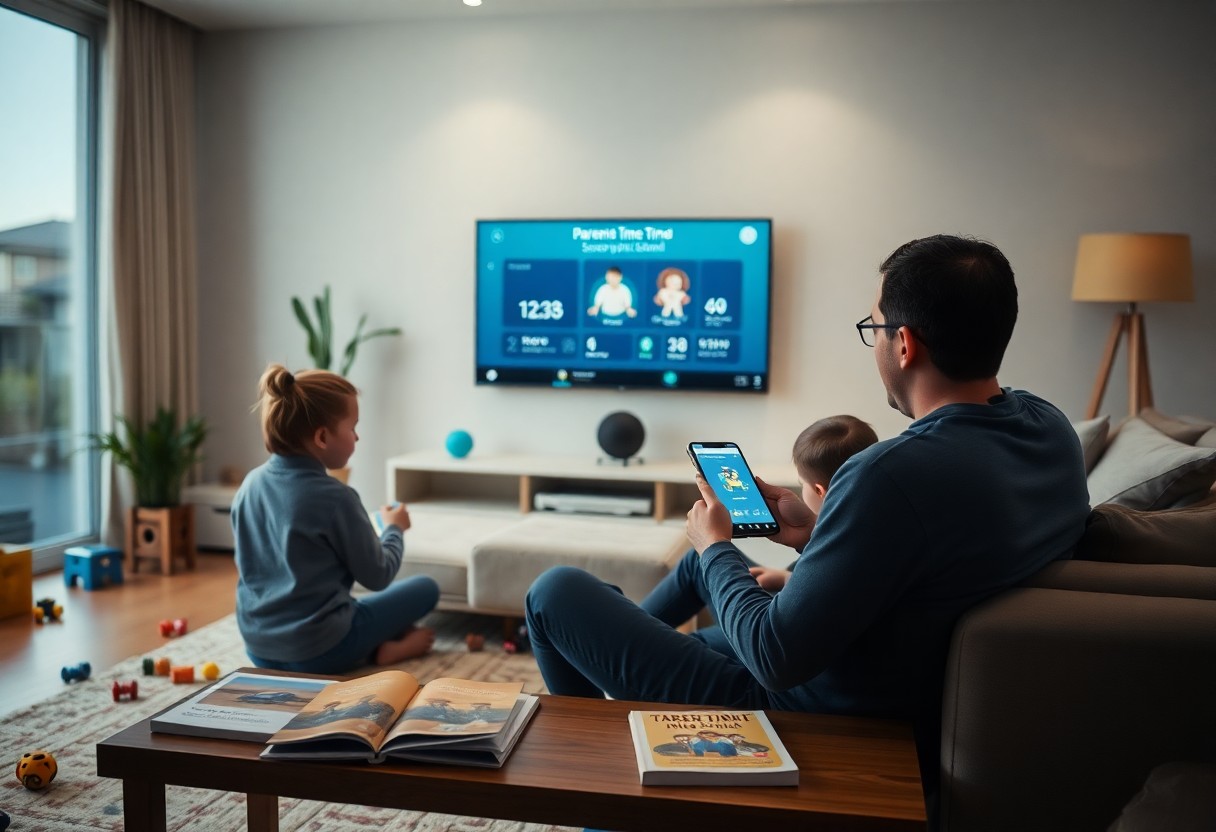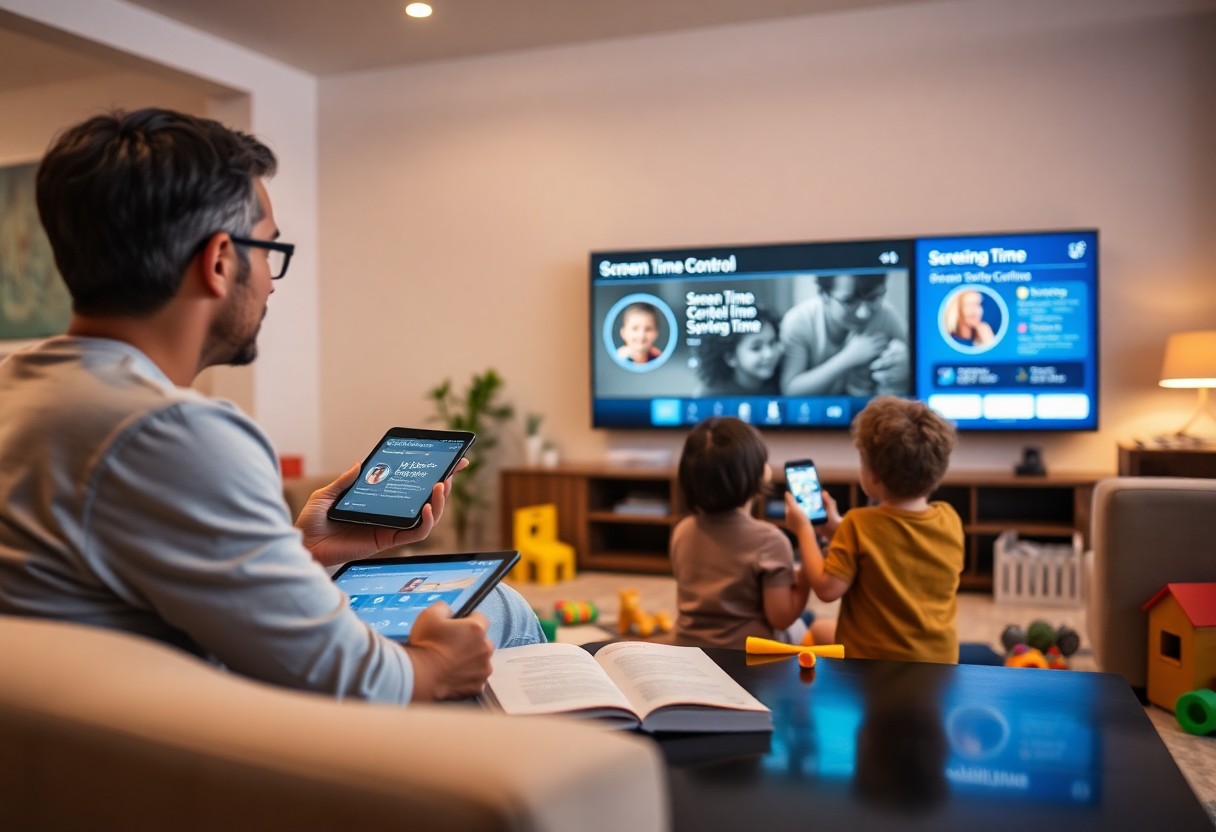Parenting in today’s digital landscape brings unprecedented challenges and opportunities. You must navigate screen time limits, ensuring that your child benefits from technology while also understanding its risks. Familiarizing yourself with internet safety practices and smart apps can empower you to create a secure and enriching environment. Balancing the advantages of digital connectivity with potential dangers is important as you guide your child through the tech era.

Key Takeaways:
- Establish clear boundaries for screen time to promote healthy habits.
- Utilize parental controls to ensure online safety and appropriate content access.
- Encourage interactive and educational apps that enhance learning and development.
- Model positive tech use to influence children’s behavior and attitudes towards screens.
- Engage in regular discussions about online safety and social media use with children.
Decoding Screen Time: What Research Says About Its Impact
The Effects of Excessive Screen Time on Child Development
Excessive screen time can lead to a myriad of developmental challenges for children. Studies indicate that children who spend more than two hours a day on screens have a higher likelihood of facing academic struggles, as attention spans may be significantly shorter. This connection is particularly evident in the growing prevalence of digital distractions that can interfere with critical thinking and problem-solving skills. In addition, the American Academy of Pediatrics highlights a direct link between high screen time and increased rates of obesity, sleep disturbances, and behavioral issues, underscoring the importance of monitoring usage.
Moreover, the emotional and social consequences of screen overexposure can profoundly affect your child’s development. A 2021 study published in JAMA Psychiatry found that increased screen time correlates with higher levels of anxiety and depression among adolescents. As social interactions move online, face-to-face communication skills may be hindered, potentially leading to difficulties in forming meaningful relationships. Prioritizing real-life engagement can foster emotional intelligence, which is crucial for a healthy social life.
Balancing Digital Engagement with Offline Activities
Finding the right balance between digital engagement and offline activities is imperative for holistic child development. Designating “tech-free” times, such as during meals or before bedtime, encourages your child to engage in alternative pastimes that foster creativity and physical health. Encouraging outdoor play or family activities can replace screen time with experiences that promote interpersonal skills, teamwork, and physical fitness. Incorporating educational yet fun screen time can also provide a more enriching experience that complements offline learning.
Integrating offline activities doesn’t mean eliminating screen interaction entirely. Establishing a routine that exemplifies balance allows for a blend of both worlds. Educational games and applications can supplement learning when managed wisely. Engaging your child in daily chores or hobbies, such as cooking or gardening, emphasizes practical skills while instilling a sense of responsibility and accomplishment. Striking this harmony ensures that technology serves as a tool for growth rather than a barrier to it.
Navigating Online Safety: Protecting Against Digital Threats
Common Risks in the Digital Landscape
You face a myriad of digital threats as you guide your children through online spaces. From cyberbullying incidents, where nearly 59% of teens have experienced online harassment, to exposure to inappropriate content, safeguarding your children is a constant challenge. Vulnerabilities also include the risk of encountering online predators, with reports indicating that 1 in 5 youths receive unwanted sexual solicitation online. Awareness of these risks helps inform your strategies in creating a secure environment for your children.
Additionally, children often fall victim to scams and phishing attempts because they may not recognize suspicious online activity. They might unwittingly share personal information or engage in chat rooms that expose them to harmful interactions. Your vigilance in educating them about these dangers is vital in fortifying their defenses against potential threats, as highlighted in the Parenting Children in the Age of Screens report.
Tools and Strategies for Safe Browsing
Equipping your children with the right tools can significantly enhance their online safety. Utilize parental control software that allows you to monitor activity and manage what content they can access. These tools can filter out inappropriate websites and provide insights into their online behavior, letting you intervene when necessary. Many devices and operating systems also come with built-in settings that allow customized privacy options and restrictions on app purchases.
Incorporating open discussions about safe online practices is beneficial as well. Creating an environment where your children feel comfortable sharing their online experiences fosters transparency. Teach them about the importance of strong passwords, recognizing secure websites, and the dangers of sharing personal information. By establishing clear rules and maintaining an ongoing conversation about their online interactions, you reinforce the notion that safety is a shared responsibility.

Smart Apps: The Pros and Cons of Digital Parenting Tools
Pros | Cons
— | —
Encourages educational engagement | Can lead to over-reliance on technology
Offers personalized learning experiences | May expose children to inappropriate content
Helps develop organizational and time-management skills | Risks distraction from other important activities
Provides instant access to information | Might encourage passive learning habits
Facilitates communication with parents | Can create privacy concerns with data usage
Top Educational Apps for Mindful Learning
Selecting the right educational apps can significantly enhance your child’s learning experience. Apps such as Kahoot! and Duolingo provide engaging ways to learn through games and interactive lessons. Meanwhile, platforms like BrainPOP cater to various subjects with animated content that makes difficult concepts more relatable. These tools promote active participation, allowing your child to engage deeply with the material rather than passively consuming information.
Mindful learning emphasizes awareness and intentional use of technology. Apps like Headspace for Kids teach mindfulness and emotional regulation, skills critical for holistic development. Integrating these top educational apps into your child’s routine not only supports academic growth but also encourages a balanced relationship with technology, fostering both learning and personal development.
The Role of Parental Controls and Monitoring Software
Parental controls and monitoring software serve as vital tools in the digital age, ensuring your child’s online activities remain safe and appropriate. By employing features on devices or through dedicated apps, you can set time limits, filter content, and track usage effectively. Tools like Norton Family or Qustodio enable you to gain insights into your child’s digital behavior, helping you to address potential issues proactively.
These tools do more than just limit access to certain content; they can help you initiate discussions about online safety and responsible usage. Transparent conversations about why certain restrictions exist can foster mutual understanding and respect between you and your child. While some may see these measures as intrusive, they truly are protective enhancements in today’s digital landscape.
Understanding the nuances of parental control options allows you to tailor them to your family’s needs. Being well-informed about features such as location tracking, screen time management, and web filtering will empower you to create a comprehensive digital environment that enhances safety while minimizing risks.
A New Paradigm: Shifting Perspectives on Tech in Parenting
Embracing Technology as a Positive Force
Technology presents an opportunity for enriched family interactions and educational advancements. When used deliberately, digital tools can facilitate meaningful connections and foster creativity. For instance, many parents have reported that engaging their children in coding games or interactive apps not only enhances problem-solving skills but also allows joint participation in exciting learning experiences. Parents who view technology as a partner in education often find their children more engaged, as they can relate course material to real-world applications.
Research indicates that embracing a proactive stance on tech can yield significant advantages. Parents who utilize exploring the perception of parents on children’s screen time see higher rates of educational achievement in children. By framing technology within a positive context, you can encourage your child to see their screen time as a vehicle for exploration rather than mere entertainment.
Developing a Family Digital Culture
Creating a family digital culture involves establishing clear guidelines around technology use that align with your family values. In families where tech is integrated thoughtfully, screens become part of shared experiences rather than isolated activities. Regular family discussions about appropriate content, online etiquette, and balancing screen time with other interests cultivate a sense of responsibility and mutual respect. For example, scheduling weekly ‘tech-free’ family nights promotes quality time spent together while engaging in offline activities.
Incorporate family rules regarding device usage, such as tech-free zones during meals or designated times for device use. This approach not only ensures that technology supports rather than detracts from family relationships but also helps you model healthy tech habits. By actively curating a positive digital environment at home, you instill values of moderation and mindfulness in your children, preparing them to navigate the digital landscape responsibly.
Encouraging Healthy Tech Use: Strategies for Parents
Establishing Screen Time Limits and Guidelines
Setting clear screen time limits is crucial for fostering a balanced digital lifestyle. You might consider adopting the American Academy of Pediatrics’ recommendation of no more than one hour of high-quality screen time per day for children ages 2 to 5. For older children, it’s beneficial to have guidelines that prioritize educational content while allowing flexibility for leisure activities. Use tools available on devices to create schedules that restrict usage during homework time or family meals, ensuring that tech doesn’t interfere with meaningful interactions.
Crafting household guidelines around screen use can involve the entire family. Collaboratively discuss what constitutes appropriate content and outline acceptable devices and times for usage. This sense of shared responsibility not only strengthens your family’s understanding of digital boundaries but also creates opportunities for dialogue about what each family member is experiencing online. As seen in various studies, engaging your kids in these discussions helps ensure they’re more likely to adhere to established norms.
Engaging in Tech-Related Family Activities
Engaging in tech-related family activities helps to underline the idea that technology can be a tool for togetherness rather than isolation. Planning game nights featuring multiplayer video games fosters collaboration, while shared projects like family blogs or coding activities encourage creativity. Taking a collective approach to using technology not only makes the experience more enjoyable but also provides opportunities for discussions about online behaviors, setting an example for your children about how to use tech responsibly.
Involving your family in tech-related activities can also extend to app usage, allowing you to explore educational platforms simultaneously. Introduce gamified learning apps that everybody can play together, blending fun with education. You might find that creating challenges based on the app helps your children remain engaged while reinforcing the lessons they’re learning. Additionally, discussing your experiences with online safety and digital etiquette while engaged in these activities creates a shared understanding of the importance of safe digital practices. Engaging in tech activities together builds a culture of shared learning and responsibility.
To wrap up
Taking this into account, navigating parenting in the tech era requires you to balance screen time with healthy real-life interactions. Establishing clear guidelines for technology use in your household can ensure that your children engage with digital devices in a meaningful way while still valuing offline activities. Consider setting limits that reflect your family’s routine and values to create a harmonious environment that supports both learning and play.
Additionally, prioritizing safety when using smart apps and online platforms is imperative. Equip yourself with knowledge about the latest tools and resources available to monitor and safeguard your child’s digital experience. By actively participating in their online world and encouraging open dialogue about tech use, you can foster an environment of trust and security, empowering your children to navigate their digital lives responsibly.
FAQ
Q: What is the recommended amount of screen time for children?
A: The American Academy of Pediatrics suggests no more than one hour of high-quality screen time each day for children aged 2 to 5 years, and consistent limits for older children and teens, ensuring a balance with other healthy activities.
Q: How can I ensure my child’s safety while using apps?
A: Use parental controls to restrict access to inappropriate content, regularly review app permissions, set privacy settings, and teach your child about safe online behavior and recognizing suspicious interactions.
Q: What types of educational apps are suitable for my child?
A: Look for apps that promote skills such as math, reading, problem-solving, or creativity. Popular categories include language learning, coding games, interactive storytelling, and art applications tailored to your child’s age.
Q: How can I manage my own screen time as a parent?
A: Set specific hours for device use, use apps that track your screen time, establish tech-free zones or times in your home, and actively participate in your child’s activities to reduce reliance on screens.
Q: What are effective ways to discuss online dangers with my child?
A: Open a dialogue about potential online risks, share real-life examples, encourage questions, establish clear rules about online behavior, and practice scenarios together to help your child recognize and handle unsafe situations.





0 Comments